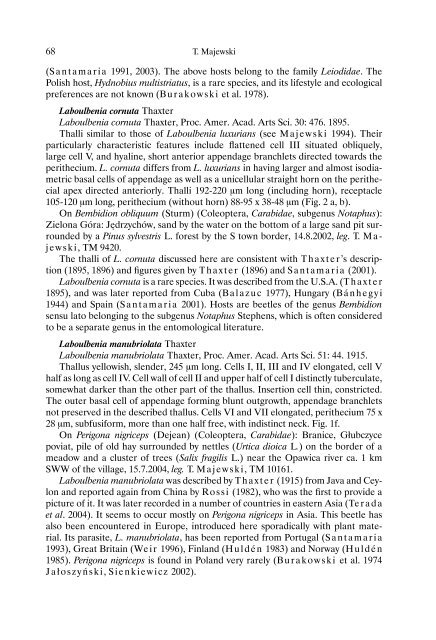Some additional Laboulbeniales (Ascomycetes) new to Poland
Some additional Laboulbeniales (Ascomycetes) new to Poland
Some additional Laboulbeniales (Ascomycetes) new to Poland
You also want an ePaper? Increase the reach of your titles
YUMPU automatically turns print PDFs into web optimized ePapers that Google loves.
68 T. Majewski<br />
(Santamaria 1991, 2003). The above hosts belong <strong>to</strong> the family Leiodidae. The<br />
Polish host, Hydnobius multistriatus, is a rare species, and its lifestyle and ecological<br />
preferences are not known (Burakowski et al. 1978).<br />
Laboulbenia cornuta Thaxter<br />
Laboulbenia cornuta Thaxter, Proc. Amer. Acad. Arts Sci. 30: 476. 1895.<br />
Thalli similar <strong>to</strong> those of Laboulbenia luxurians (see Majewski 1994). Their<br />
particularly characteristic features include flattened cell III situated obliquely,<br />
large cell V, and hyaline, short anterior appendage branchlets directed <strong>to</strong>wards the<br />
perithecium. L. cornuta differs from L. luxurians in having larger and almost isodiametric<br />
basal cells of appendage as well as a unicellular straight horn on the perithecial<br />
apex directed anteriorly. Thalli 192-220 μm long (including horn), receptacle<br />
105-120 μm long, perithecium (without horn) 88-95 x 38-48 μm (Fig. 2 a, b).<br />
On Bembidion obliquum (Sturm) (Coleoptera, Carabidae, subgenus Notaphus):<br />
Zielona Góra: Jędrzychów, sand by the water on the bot<strong>to</strong>m of a large sand pit surrounded<br />
by a Pinus sylvestris L. forest by the S <strong>to</strong>wn border, 14.8.2002, leg. T. Majewski,<br />
TM 9420.<br />
The thalli of L. cornuta discussed here are consistent with Thaxter’s description<br />
(1895, 1896) and figures given by Thaxter (1896) and Santamaria (2001).<br />
Laboulbenia cornuta is a rare species. It was described from the U.S.A. (Thaxter<br />
1895), and was later reported from Cuba (B a l a z u c 1977), Hungary (B á nhegyi<br />
1944) and Spain (Santamaria 2001). Hosts are beetles of the genus Bembidion<br />
sensu la<strong>to</strong> belonging <strong>to</strong> the subgenus Notaphus Stephens, which is often considered<br />
<strong>to</strong> be a separate genus in the en<strong>to</strong>mological literature.<br />
Laboulbenia manubriolata Thaxter<br />
Laboulbenia manubriolata Thaxter, Proc. Amer. Acad. Arts Sci. 51: 44. 1915.<br />
Thallus yellowish, slender, 245 μm long. Cells I, II, III and IV elongated, cell V<br />
half as long as cell IV. Cell wall of cell II and upper half of cell I distinctly tuberculate,<br />
somewhat darker than the other part of the thallus. Insertion cell thin, constricted.<br />
The outer basal cell of appendage forming blunt outgrowth, appendage branchlets<br />
not preserved in the described thallus. Cells VI and VII elongated, perithecium 75 x<br />
28 μm, subfusiform, more than one half free, with indistinct neck. Fig. 1f.<br />
On Perigona nigriceps (Dejean) (Coleoptera, Carabidae): Branice, Głubczyce<br />
poviat, pile of old hay surrounded by nettles (Urtica dioica L.) on the border of a<br />
meadow and a cluster of trees (Salix fragilis L.) near the Opawica river ca. 1 km<br />
SWW of the village, 15.7.2004, leg. T. Majewski, TM 10161.<br />
Laboulbenia manubriolata was described by T h a xter (1915) from Java and Ceylon<br />
and reported again from China by Rossi (1982), who was the first <strong>to</strong> provide a<br />
picture of it. It was later recorded in a number of countries in eastern Asia (Terada<br />
et al. 2004). It seems <strong>to</strong> occur mostly on Perigona nigriceps in Asia. This beetle has<br />
also been encountered in Europe, introduced here sporadically with plant material.<br />
Its parasite, L. manubriolata, has been reported from Portugal (Santamaria<br />
1993), Great Britain (Weir 1996), Finland (H uldén 1983) and Norway (Huldén<br />
1985). Perigona nigriceps is found in <strong>Poland</strong> very rarely (B u rakowski et al. 1974<br />
Jałoszyński, Sienkiewicz 2002).
















